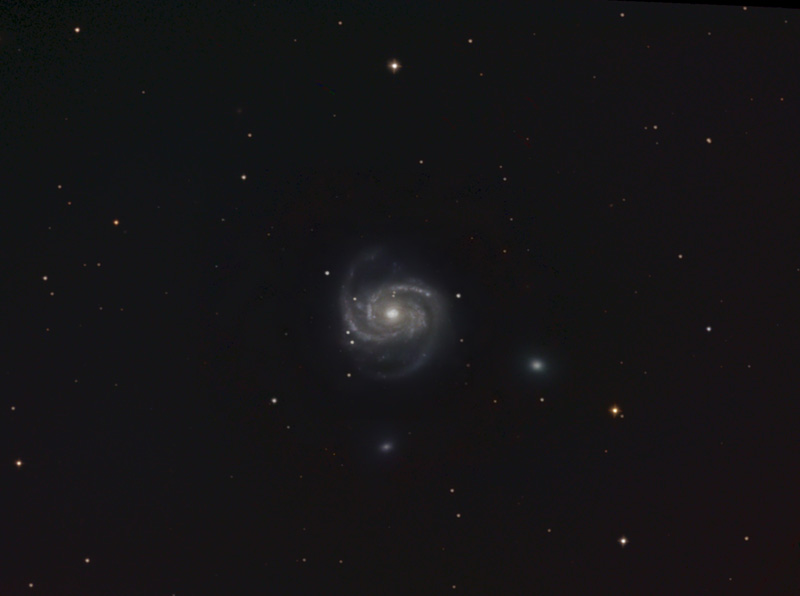

Image Centered on Ra 12 : 22.9 (h:m) Dec +15 : 49 (deg:m) Distance 60 million light years
M100 Spiral Galaxy (NGC 4321), type Sc, in Coma Berenices
Fullsize Color image ( very large file )
Information ( From the SEDS website )
Discovered by Pierre Méchain in
1781.
On March 15, 1781, Pierre Méchain discovered this object, M100, together with
its apparent neighbors, M98 and M99. His friend, Charles Messier, obtained its
position on April 13, 1781, and included it in his catalog, immediately before
finishing the third, final published edition.
M100 is one of the brightest member galaxies of the Virgo Cluster of galaxies.
M100 is a spiral galaxy, like our Milky Way, and tilted nearly face-on as seen
from earth. It is among the first spirals that have been discovered, and listed
by Lord Rosse as one of 14 "spiral nebulae" discovered to 1850. The galaxy has
two prominent arms of bright blue stars and several fainter arms. The blue stars
in the arms are young hot and massive stars which formed recently from density
perturbations caused by interactions with neighboring galaxies which are lying
just outside our image. Despite its nearly perfect symmetric outline, this
galaxy appears slightly asymmetric, as on the southern (lower) side of the
nucleus more (or brighter) young stars have formed.
Deep photographs of M100 have revealed that this galaxy is actually much larger
than shown in conventional photographs. Therefore, a significant part of the
galaxy's mass may lie in the faint outer regions and escape its discovery in
conventional images.
M100 has been imaged extensively by the Hubble Space Telescope, which finally
led to the discovery of over 20 Cepheids as well as one nova, and a distance
determination of 56+/-6 million light years for M100, the first considerably
reliable distance determination of a Virgo cluster galaxy (see H0 Key Project,
paper IV, 1996). The high improvement of photographic resolution by the HST may
be noticed in this comparison of HST to average quality KPNO 2.1m-photos.
Diane Dutkevitch of the Northwestern University has provided a Astronomy Web Lab
on distance determination of M100 from HST Cepheid observations.
In the inner disk of M100 has been investigated by Nasa's Ultraviolet Imaging
Telescope on its Astro-1 Space Shuttle mission. Intense star formation activity
was found to take place in a ring of starburst activity along the periphery of
the galaxy's innermost spiral arms.
M100 is located in the spring constellation Coma Berenices and can be seen
through a moderate-sized amateur telescope. Amateurs can see the central regions
of this galaxy as faint elliptical patch of uneven texture in small telescopes,
or even in good binoculars. Under good observing conditions, suggestions of the
inner spiral arms can be glimpsed in telescopes starting at 4 inch aperture
(refractor or unobstructed reflector). Photos reveal the grand design spiral
structure, as seen in every picture from our collection of amateur images of
M100.
Optics and Exposure data
The image of m100 shown on this page was obtained with a 10 inch newtonian telescope manufactured by Parks Optical. The Image was a "1st light" test of the optics and focuser. overall Im pleased with this scope considering the relatively low price of around 1500.00 U.S. dollars. I plan on replacing the stock focuser with an electric remote focuser at some future date. I dont believe I have been able to achieve optimum focus with the scopes current stock focuser due to it's coarse motion control and some image shift during focusing. .
Telescope, Parks Optical 10 inch newtonian @ F5 and a Televue Coma Corrector which increases the focal ratio slightly to an F5.5 equaling a focal length of roughly 1300 mm .
Vixen Newtonian R200SS used to acquire color data. Combined in maxin Dl and aligned with luminance with registar
Mount, Losmandy G11 with Gemini control electronics
Imager, Starlite-Xpress SXV-h9 using Astronomiks RGB optical filters.
60 minutes luminance using 2 minute subexposures , RGB = 20 minutes each color. no binning
Images acquired with Astroart and aligned then combined in Maxim Dl. Final RGB composite processed with Photoshop Cs
Images acquired from my backyard - " Dirt Clod Observatory" in Antelope California